Ekgecg Interpretation Basic Easy and Simple
This guide demonstrates how to read an ECG using a systematic approach. If you want to put your ECG estimation knowledge to the exam, check out our ECG quiz on the Geeky Medics quiz platform.
You may also exist interested in our ECG flashcard deck which can be purchased every bit function of our collection of 1000+ OSCE flashcards.
Confirm details
Before commencement ECG interpretation, yous should bank check the following details:
- Confirm the name and appointment of birth of the patient matches the details on the ECG.
- Check the date and time that the ECG was performed.
- Check the scale of the ECG (normally 25mm/s and 10mm/1mV).
You might also exist interested in our OSCE Flashcard Drove which contains over 2000 flashcards that cover clinical examination, procedures, advice skills and data interpretation.
Heart rate
What's a normal developed eye charge per unit?
- Normal: 60-100 bpm
- Tachycardia: > 100 bpm
- Bradycardia: < 60 bpm
Regular heart rhythm
If a patient has a regular eye rhythm their middle rate can exist calculated using the following method:
- Count the number of large squares present inside i R-R interval.
- Divide 300 by this number to calculate center rate.
Middle rate calculation example
- 4 large squares in an R-R interval
- 300/four = 75 beats per minute
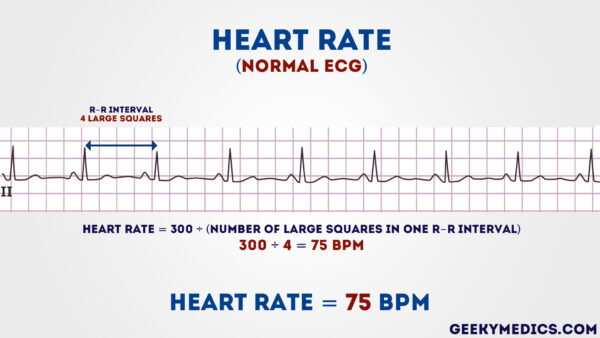
Irregular heart rhythm
If a patient'due south eye rhythm is irregular the first method of heart rate calculation doesn't work (equally the R-R interval differs significantly throughout the ECG). As a result, yous need to employ a different method:
- Count the number of complexes on the rhythm strip (each rhythm strip is typically 10 seconds long).
- Multiply the number of complexes by 6 (giving you the average number of complexes in 1 infinitesimal).
Heart charge per unit calculation example
- ten complexes on a rhythm strip
- x x 6 = 60 beats per minute
Middle rhythm
A patient'south centre rhythm tin can be regular or irregular.
Irregular rhythms can be either:
- Regularly irregular (i.e. a recurrent pattern of irregularity)
- Irregularly irregular (i.due east. completely disorganised)
Mark out several consecutive R-R intervals on a slice of paper, then movement them along the rhythm strip to bank check if the subsequent intervals are similar.
Hint
If you are suspicious that there is some atrioventricular block (AV block), map out the atrial charge per unit and the ventricular rhythm separately (i.e. mark the P waves and R waves). As you move along the rhythm strip, y'all tin then run across if the PR interval changes, if QRS complexes are missing or if there is complete dissociation between the two.
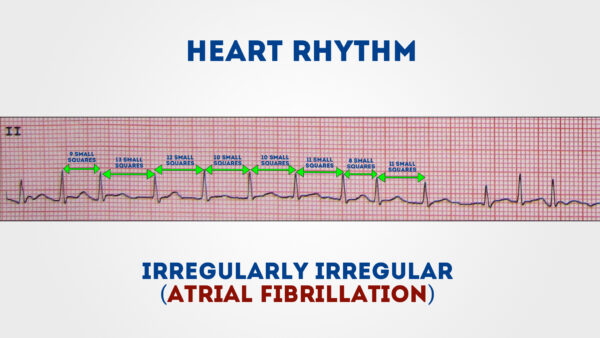
Cardiac centrality
Cardiac centrality describes the overall direction of electrical spread inside the heart.
In a healthy individual, the axis should spread from 11 o'clock to 5 o'clock.
To decide the cardiac axis yous demand to look at leads I, 2 and 3.
Read our cardiac centrality guide to acquire more.
Normal cardiac axis
Typical ECG findings for normal cardiac axis:
- Lead II has the most positive deflection compared to leads I and III.
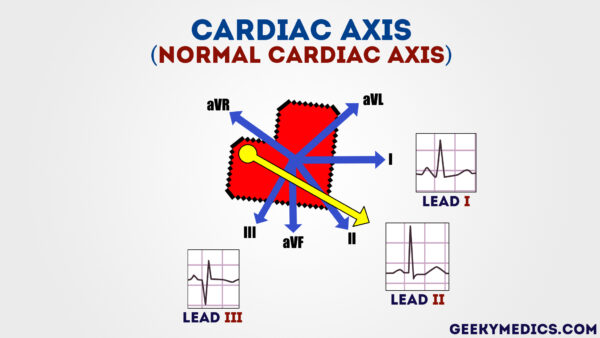
Right axis deviation
Typical ECG findings for right axis deviation:
- Lead Iii has the well-nigh positive deflection and lead I should exist negative.
- Correct axis deviation is associated with right ventricular hypertrophy.
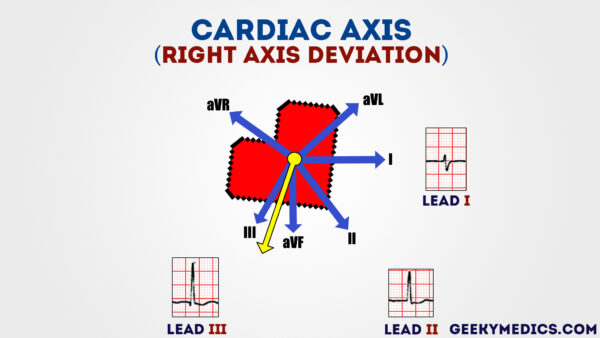
Left centrality difference
Typical ECG findings for left centrality deviation:
- Pb I has the nearly positive deflection.
- Leads II and III are negative.
- Left axis departure is associated with heart conduction abnormalities.

P waves
The next step is to look at the P waves and reply the post-obit questions:
1. Are P waves present?
2. If so, is each P moving ridge followed by a QRS complex?
three. Exercise the P waves look normal? – check duration, direction and shape
four. If P waves are absent, is in that location any atrial activity?
- Sawtooth baseline → palpitate waves
- Chaotic baseline → fibrillation waves
- Apartment line → no atrial activity at all
Hint
If P waves are absent-minded and there is an irregular rhythm it may suggest a diagnosis of atrial fibrillation.
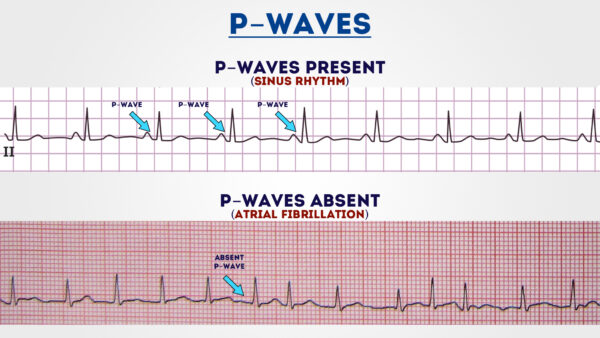
PR interval
The PR interval should exist between 120-200 ms(3-5 modest squares).
Prolonged PR interval (>0.two seconds)
A prolonged PR interval suggests the presence of atrioventricular delay (AV block).
Outset-degree heart block (AV cake)
Kickoff-degree centre block involves a fixed prolonged PR interval (>200 ms).
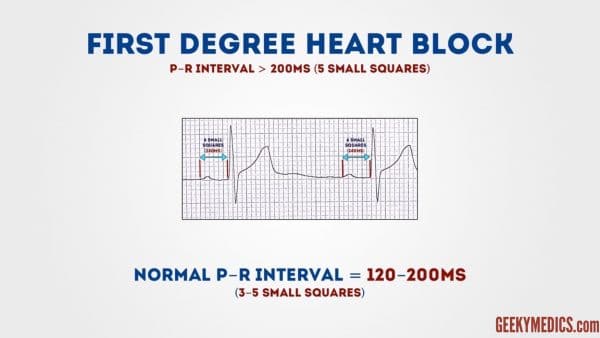
Second-caste middle block (type 1)
Second-degree AV block (type 1) is also known asMobitz type 1 AV block orWenckebach phenomenon.
Typical ECG findings in Mobitz blazon 1 AV block includeprogressive prolongation of the PR interval until eventually the atrial impulse is not conducted and theQRS complex is dropped.
AV nodal conductionresumes with the next beat out and the sequence of progressive PR interval prolongation and the eventual dropping of a QRS complexrepeats itself.
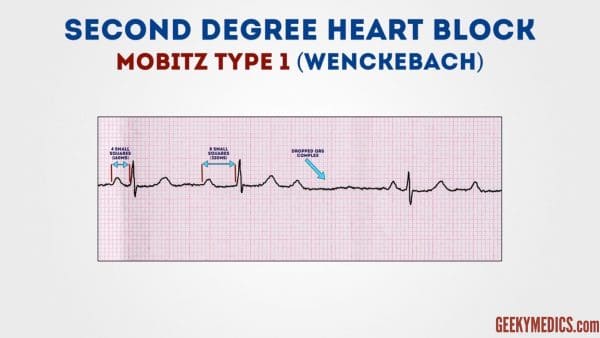
2d-degree heart block (blazon two)
2d-caste AV cake (type 2) is also known asMobitz blazon 2 AV block.
Typical ECG findings in Mobitz type 2 AV block include a consistent PR interval duration withintermittently dropped QRS complexes due to a failure of conduction.
The intermittent dropping of the QRS complexes typically follows arepeating wheel of every3rd (3:i block) orfourth (4:1 cake)P wave.
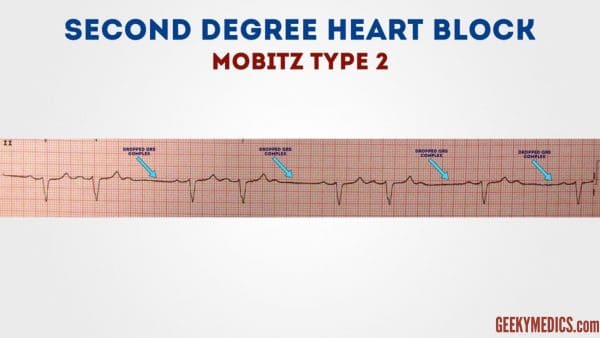
Third-caste heart block (complete eye block)
Third-degree (complete) AV block occurs when at that place is no electrical communicationbetwixt theatria andventricles due to a complete failure of conduction.
Typical ECG findings include thepresence of P waves andQRS complexes that takeno association with each other, due to the atria and ventricles functioning independently.
Cardiac function is maintained by ajunctional orventricularpacemaker.
Narrow-complex escape rhythms (QRS complexes of <0.12 seconds elapsing) originateabove the bifurcation of thebundle of His.
Wide-complex escape rhythms (QRS complexes >0.12 seconds duration) originate frombelow the bifurcation of the parcel of His.
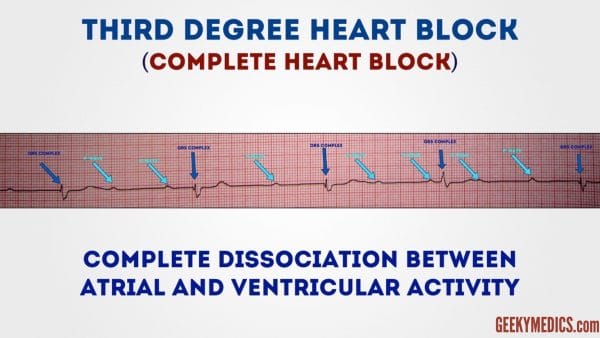
Tips for remembering types of heart block
To help remember the various types of AV cake, it is useful to know the anatomical location of the cake within the conducting system.
First-degree AV block:
- Occurs between the SA node and the AV node (i.due east. within the atrium).
2d-degree AV block:
- Mobitz I AV block (Wenckebach) occurs IN the AV node (this is the simply slice of conductive tissue in the heart which exhibits the power to conduct at different speeds).
- Mobitz Ii AV block occurs Subsequently the AV node in the bundle of His or Purkinje fibres.
Third-degree AV block:
- Occurs at or afterward the AV node resulting in a complete blockade of distal conduction.
Shortened PR interval
If the PR interval is shortened, this can hateful one of two things:
- Simply, the P wave is originating from somewhere closer to the AV node and so the conduction takes less fourth dimension (the SA node is not in a stock-still place and some people'due south atria are smaller than others).
- The atrial impulse is getting to the ventricle by a faster shortcut instead of conducting slowly across the atrial wall. This is an accompaniment pathway and tin be associated with a delta wave (run into below which demonstrates an ECG of a patient with Wolff Parkinson White syndrome).
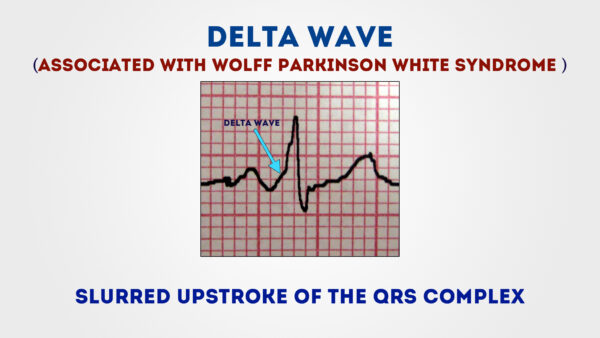
QRS complex
When assessing a QRS complex, y'all demand to pay attending to the post-obit characteristics:
- Width
- Height
- Morphology
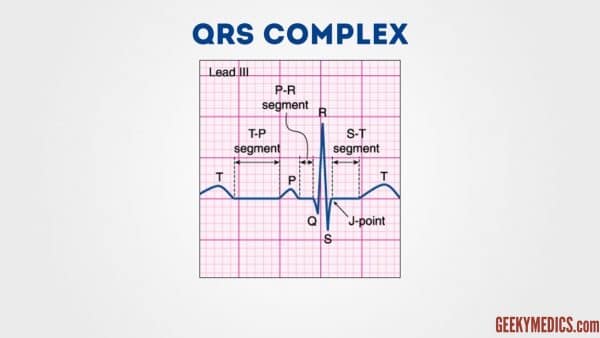
Width
Width tin can exist described as NARROW (< 0.12 seconds) or BROAD (> 0.12 seconds):
- A narrow QRS complex occurs when the impulse is conducted down the package of His and the Purkinje fibre to the ventricles. This results in well organised synchronised ventricular depolarisation.
- A broad QRS complex occurs if at that place is an abnormal depolarisation sequence – for instance, a ventricular ectopic where the impulse spreads slowly across the myocardium from the focus in the ventricle. In contrast, an atrial ectopic would result in a narrow QRS complex because information technology would behave downwards the normal conduction arrangement of the heart. Similarly, a bundle branch block results in a broad QRS complex because the impulse gets to one ventricle chop-chop down the intrinsic conduction arrangement then has to spread slowly beyond the myocardium to the other ventricle.
Height
Height tin be described as either SMALL or TALL:
- Small complexes are defined as < 5mm in the limb leads or < x mm in the breast leads.
- Alpine complexes imply ventricular hypertrophy (although can be due to trunk habitus e.thou. alpine slim people). There are numerous algorithms for measuring LVH, such every bit the Sokolow-Lyon index or the Cornell index.
Morphology
To assess morphology, you need to appraise the individual waves of the QRS complex.
Delta wave
The mythical 'delta wave' is a sign that the ventricles are being activated earlier than normal from a signal afar to the AV node. The early on activation then spreads slowly across the myocardium causing the slurred upstroke of the QRS complex.
Annotation – the presence of a delta wave does Not diagnose Wolff-Parkinson-White syndrome. This requires evidence of tachyarrhythmias AND a delta wave.

Q-waves
Isolated Q waves can be normal.
A pathological Q wave is > 25% the size of the R wave that follows information technology or > 2mm in height and > 40ms in width.
A single Q moving ridge is not a cause for concern – look for Q waves in an unabridged territory (e.one thousand. anterior/inferior) for testify of previous myocardial infarction.

R and S waves
Assess the R moving ridge progression beyond the chest leads (from small in V1 to large in V6).
The transition from S > R wave to R > S wave should occur in V3 or V4.
Poor progression (i.e. S > R through to leads V5 and V6) tin be a sign of previous MI merely tin besides occur in very large people due to poor lead position.
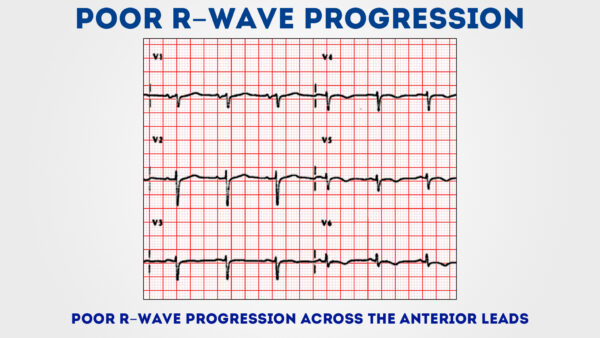
J point segment
The J point is where the S wave joins the ST segment.
This point tin be elevated resulting in the ST segment that follows information technology as well being raised (this is known as "high accept-off").
Loftier take-off (or benign early repolarisation to give its full title) is a normal variant that causes a lot of angst and confusion as it LOOKS like ST top.
Key points for assessing the J betoken segment:
- Beneficial early repolarisation occurs mostly under the age of 50 (over the historic period of 50, ischaemia is more mutual and should exist suspected first).
- Typically, the J point is raised with widespread ST elevation in multiple territories making ischaemia less likely.
- The T waves are also raised (in dissimilarity to a STEMI where the T wave remains the same size and the ST segment is raised).
- The ECG abnormalities do not modify! During a STEMI, the changes will evolve – in benign early on repolarisation, they volition remain the aforementioned.
ST segment
The ST segment is the part of the ECG between the cease of the S wave and the showtime of the T wave.
In a salubrious individual, information technology should be an isoelectric line (neither elevated nor depressed).
Abnormalities of the ST segment should be investigated to rule out pathology.

ST-height
ST-elevation is pregnant when it is greater than i mm (1 small square)in 2 or more contiguous limb leads or >2mm in two or more chest leads.
Information technology is nearly commonly caused past acute total-thickness myocardial infarction.

ST depression
ST depression ≥ 0.5 mm in ≥ 2 contiguous leads indicates myocardial ischaemia.

T waves
T waves represent repolarisation of the ventricles.
Tall T waves
T waves are considered tall if they are:
- > 5mm in the limb leads AND
- > 10mm in the chest leads (the aforementioned criteria as 'minor' QRS complexes)
Tall T waves can be associated with:
- Hyperkalaemia ("tall tented T waves")
- Hyperacute STEMI

Inverted T waves
T waves are unremarkably inverted in V1 and inversion in atomic number 82 Three is a normal variant.
Inverted T waves in other leads are a nonspecific sign of a wide diversity of atmospheric condition:
- Ischaemia
- Bundle branch blocks (V4-6 in LBBB and V1-V3 in RBBB)
- Pulmonary embolism
- Left ventricular hypertrophy (in the lateral leads)
- Hypertrophic cardiomyopathy (widespread)
- General illness
Around 50% of patients admitted to ITU have some show of T moving ridge inversion during their stay.
Observe the distribution of the T wave inversion (e.g. anterior/lateral/posterior leads).
You must have this ECG finding and apply information technology in the context of your patient.
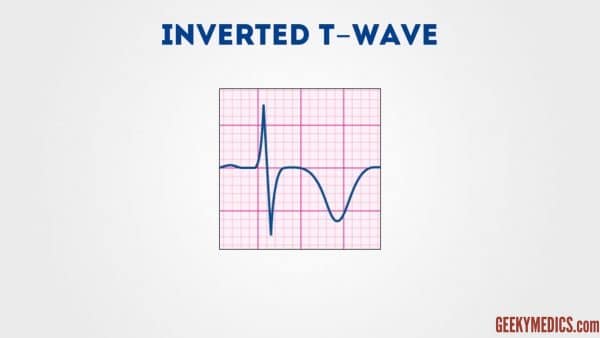
Biphasic T waves
Biphasic T waves take two peaks and can exist indicative of ischaemia and hypokalaemia.

Flattened T waves
Flattened T waves are a non-specific sign, that may correspond ischaemia or electrolyte imbalance.
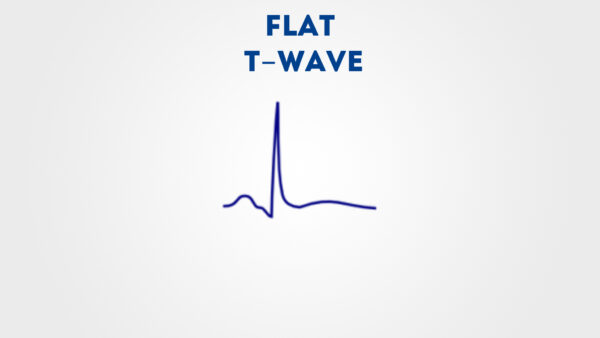
U waves
U waves are non a mutual finding.
The U moving ridge is a > 0.5mm deflection subsequently the T moving ridge best seen in V2 or V3.
These get larger the slower the bradycardia – classically U waves are seen in various electrolyte imbalances, hypothermia and secondary to antiarrhythmic therapy (such as digoxin, procainamide or amiodarone).
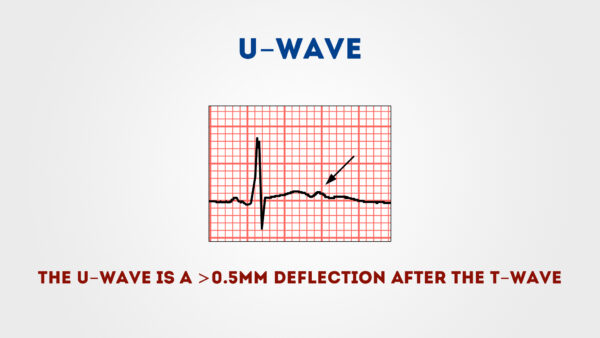
Document your interpretation
You should certificate your interpretation of the ECG in the patient'due south notes (check out our guide to documenting an ECG).
References
- James Heilman, MD. Fast atrial fibrillation. Licence: CC BY-SA three.0.
- Michael Rosengarten BEng, Doc.McGill. Correct centrality deviation. Licence: CC Past-SA 3.0.
- James Heilman, MD. Mobitz type ii AV block. Licence: CC BY-SA 3.0.
- James Heilman, MD. Consummate heart block. Licence: CC By-SA 3.0.
- James Heilman, Doc. Delta wave. Licence: CC By-SA 3.0.
- Michael Rosengarten BEng, Md.McGill. Q-waves. Licence: CC By-SA 3.0.
- Michael Rosengarten BEng, MD.McGill. Poor R-wave progression. Licence: CC Past-SA 3.0.
- Michael Rosengarten BEng, MD.McGill. Alpine tented T-waves. Licence: CC Past-SA 3.0.
- CardioNetworks. T-wave morphology. Licence: CC Past-SA 3.0.
- James Heilman, Physician. U-wave. Licence: CC Past-SA 3.0.
- Michael Rosengarten BEng, MD.McGill. Left axis difference. Licence: CC BY-SA iii.0.
garretsontwoun1957.blogspot.com
Source: https://geekymedics.com/how-to-read-an-ecg/

0 Response to "Ekgecg Interpretation Basic Easy and Simple"
Post a Comment